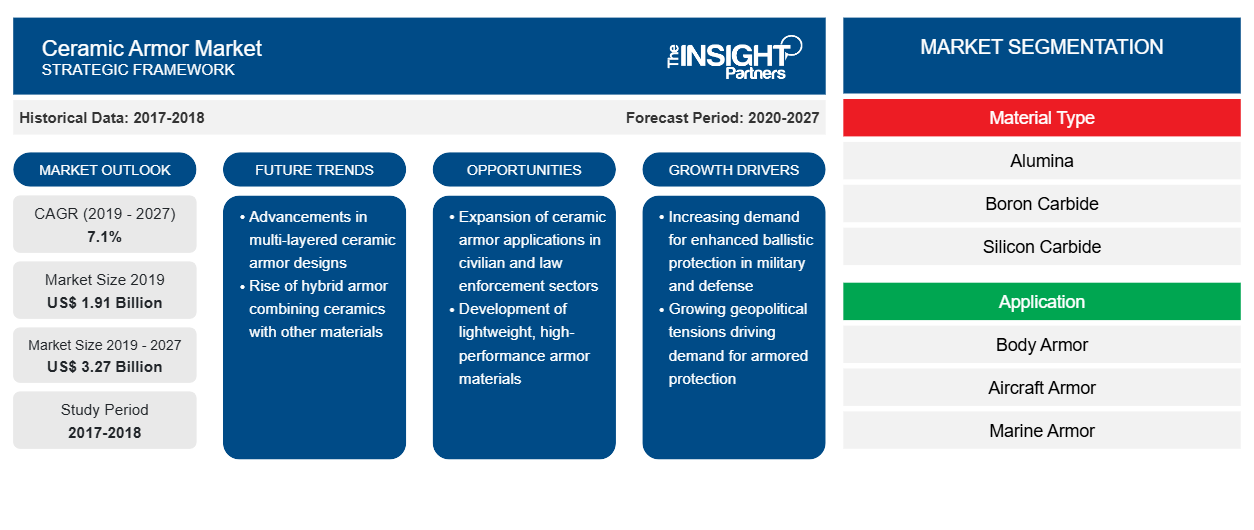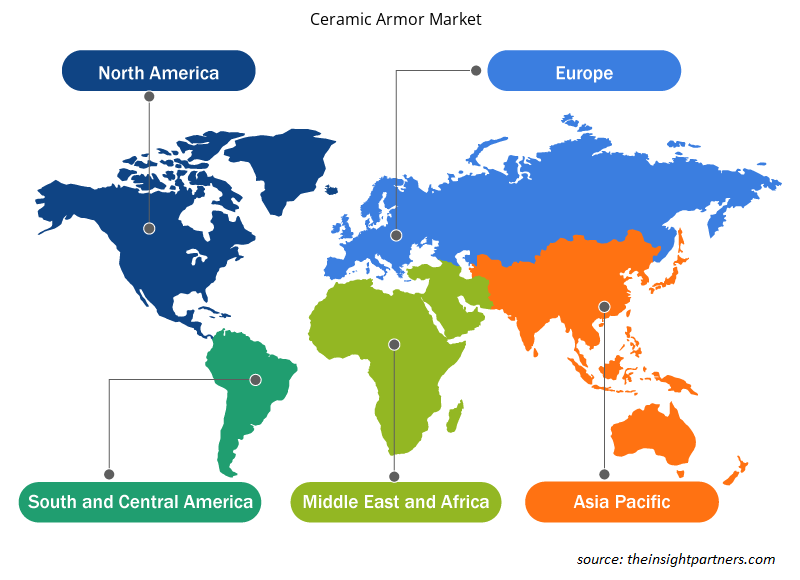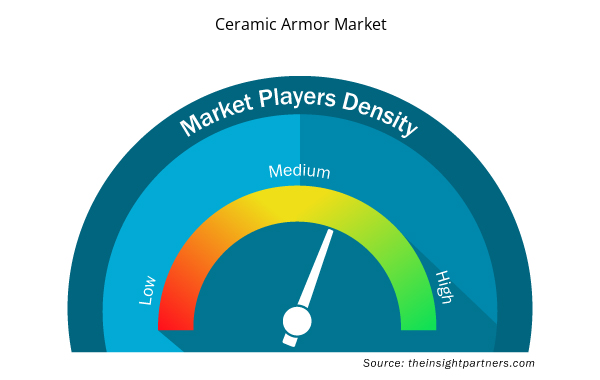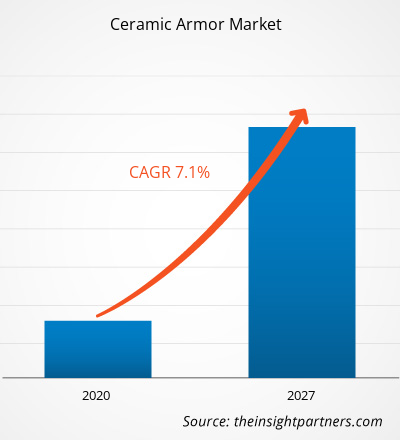The ceramic armor market was valued at US$ 1,911.26 million in 2019 and is projected to reach US$ 3,273.35 million by 2027; it is expected to grow at a CAGR of 7.1% during the forecast period.
Ceramic armors are widely utilized in body armor, aircraft armor, marine armor, vehicle armor, and so on. They are lightweight and highly flexibility, which has been one of the key factors driving their demand. The increasing spending by various countries on the security of their military forces has been another factor contributing to the expansion of the ceramic armor market across the world. The growth of the aerospace & defense industry in different countries—mainly due to the mounting defense spending in countries such as Japan, the US, China, and India is escalating the demand for this armor. For instance, the military expenditure in India, China, and Russia increased by 8.5%, 5.4%, and 5.9%, respectively, in 2018. Lightweight air support aircraft, armored ground vehicles, maritime patrol ships, and aircraft are among the equipment having high demand. Ceramic plates are mainly inserted in soft ballistic vests to limit the penetration ability of projectile. They offer projectile resistance with comprehensive strength. Alumina and silicone are among the vital ceramic fiber materials in the manufacturing of ballistic protection materials. The ceramic plates are inserted in soft ballistic vests deflect the bullet by pushing it out with the same force. Since the cost of ballistic ceramic materials such as alumina is low, it is ideal for use in automobiles, whereas silicon carbide is primarily used to protect vehicles against large projectiles. Ceramic composites have replaced armor plate steel, which was traditionally in use in the manufacturing of military vehicles.
North America is expected to hold the largest share of the global ceramic armor market during the forecast period. Several domestic and international companies have a strong foothold in the North American region. The US is a major market for ceramic armor in the region, followed by Canada and Mexico. The region largely supports the growth of the ceramic armor market through effective manufacturing and trade policies. As ceramic Armors are widely used to protect the concerned people against bullet penetrations and blast fragments, the law of legalizing guns has been one of the factors fueling the ceramic armors market in North America. The high strength and superior hardness of the silicon carbide materials provide them resistant against rifle bullets.
The USA, India, Brazil, Russia, France, Italy, UK, Spain and Argentina are among the most-affected nations in terms of confirmed cases and reported deaths, as of December 2020. According to the WHO data as of December, 2020 ~68, 165, 877 affirmed cases and 1,557,385 deaths have been reported in the world. The pandemic has affected economies due to lockdowns, travel bans, and business shutdowns. The global chemicals and materials industry is one of the major businesses enduring supply chain breaks and manufacturing disruptions due to these restrictions. China is the global hub of manufacturing and the largest raw material supplier for various industries. The lockdown of various plants and factories leading regions, such as Asia Pacific and Europe, is affecting the global supply chains and negatively impacting the manufacturing, delivery schedules, and product sales. These factors have adversely affected the global ceramic armor market growth.
Customize This Report To Suit Your Requirement
You will get customization on any report - free of charge - including parts of this report, or country-level analysis, Excel Data pack, as well as avail great offers and discounts for start-ups & universities
Ceramic Armor Market: Strategic Insights

- Get Top Key Market Trends of this report.This FREE sample will include data analysis, ranging from market trends to estimates and forecasts.
You will get customization on any report - free of charge - including parts of this report, or country-level analysis, Excel Data pack, as well as avail great offers and discounts for start-ups & universities
Ceramic Armor Market: Strategic Insights

- Get Top Key Market Trends of this report.This FREE sample will include data analysis, ranging from market trends to estimates and forecasts.
Market Insights
Growth of Aerospace & Defense Industry
The growth of the aerospace & defense industry—mainly due to the surging defense expenditure in countries such as Japan, the US, China, and India—propels the demand for ceramic armor. The rise in expenditure is primarily aimed at providing improved protection to the military forces. Military modernization programs, focused on soldier survivability as one of the prime goals, lead the defense sectors worldwide to invest heavily in novel armor materials, including ceramic, which are light in weight and provide superior ballistic performance; the ceramics form an integral part of modern armor systems. Ceramic is considered an alternative to steel to meet the performance requirements of body armors. Ceramics have greater advantages in terms of weight and design flexibility; a basic ceramic composite armor system is nearly half the weight of a similar steel-based variant.
Material Type Insights
Based on material type, the ceramic armor material market is segmented into alumina, boron carbide, silicon carbide, ceramic matrix composite, and others; in 2019, the alumina segment dominated the market. Alumina, i.e., aluminum oxide (Al2O3), is produced from bauxite, an ore mined from topsoil in various tropical and subtropical regions. Alumina provides the best cost-benefit ratio among advanced ceramic; it features high refractoriness and high elasticity modulus as well as hardness at relatively lower costs. In armor structures, ceramic are normally backed by metal plates, with or without a composite layer sandwiched between them. Alumina is used in lightweight body armor, and it is also considered a vital ceramic fiber material, mainly in the manufacturing of ballistic protection materials. The ceramic plates inserted in soft ballistic vests deflect bullets by pushing it out with the same force. The low cost of ballistic ceramic materials such as alumina makes it ideal for use in automobiles. Military vehicles were traditionally manufactured with the help of armor plate steel, which is now replaced by ceramic composites.
Application Insights
Based on application, the ceramic armor market is segmented into body armor, aircraft armor, marine armor, vehicle armor, and others. In 2019, the body armor segment dominated the market. Body armor is a protective clothing designed to absorb or deflect physical attacks. Historically, it is used to protect military personnel; however, nowadays, it is also being used by various types police forces (riot-control forces in particular), private security guards or bodyguards, and, occasionally, ordinary civilians. Regular non-plated body armor for moderate to substantial protection and hard-plate reinforced body armor for maximum protection are the two main types of ceramic armor. A ballistic vest, or bullet-resistant or bulletproof vest, is a body armor product that helps absorb the impact of firearm-fired projectiles and explosion-led shrapnel by reducing or stopping their penetration to the torso. This armor is worn by many police officers, prison guards, and a few civilians in a soft form to gain protection against stabbing attacks, executed using metallic or para-aramid components; a hard form aids protection against rifle ammunition, and is thus worn by tactical police units, soldiers, and special forces. Kevlar, steel, and polyethylene are the most used materials in the manufacture of body armor.
Key players present in the global ceramic armor market include 3M, BAE Systems Plc., Coorstek, Inc., CeramTec GmbH, Morgan Advanced Materials Plc., Koninklijke Ten Cate BV, Point Blank Enterprises, Inc, Safariland, LLC., Seyntex N.V., and Compagnie de Saint Gobain SA. These companies are implementing new product development, and merger and acquisition strategies to enlarge their respective clientele and gain significant market share in the global market, which, in turn, allows them to maintain their brand name.
Report Spotlights
- Progressive industry trends in the global ceramic armor market that help players develop effective long-term strategies
- Business growth strategies adopted by developed and developing markets
- Quantitative analysis of the global ceramic armor market from 2017 to 2027
- Estimation of global ceramic armor demand across various industries
- PEST analysis to illustrate the efficacy of buyers and suppliers operating in the industry
- Recent developments to understand the competitive market scenario and global ceramic armor demand
- Market trends and outlook, and factors driving and restraining the growth of the global ceramic armor market
- Understanding of strategies that underpin commercial interest with regard to the market growth
- Global ceramic armor market size at various nodes of market
- Detailed overview and segmentation of the market, as well as its industry dynamics
- Global ceramic armor market size in various regions with promising growth opportunities in the respective regions
Ceramic Armor Market Regional Insights
The regional trends and factors influencing the Ceramic Armor Market throughout the forecast period have been thoroughly explained by the analysts at Insight Partners. This section also discusses Ceramic Armor Market segments and geography across North America, Europe, Asia Pacific, Middle East and Africa, and South and Central America.

- Get the Regional Specific Data for Ceramic Armor Market
Ceramic Armor Market Report Scope
| Report Attribute | Details |
|---|---|
| Market size in 2019 | US$ 1.91 Billion |
| Market Size by 2027 | US$ 3.27 Billion |
| Global CAGR (2019 - 2027) | 7.1% |
| Historical Data | 2017-2018 |
| Forecast period | 2020-2027 |
| Segments Covered |
By Material Type
|
| Regions and Countries Covered | North America
|
| Market leaders and key company profiles |
Ceramic Armor Market Players Density: Understanding Its Impact on Business Dynamics
The Ceramic Armor Market is growing rapidly, driven by increasing end-user demand due to factors such as evolving consumer preferences, technological advancements, and greater awareness of the product's benefits. As demand rises, businesses are expanding their offerings, innovating to meet consumer needs, and capitalizing on emerging trends, which further fuels market growth.
Market players density refers to the distribution of firms or companies operating within a particular market or industry. It indicates how many competitors (market players) are present in a given market space relative to its size or total market value.
Major Companies operating in the Ceramic Armor Market are:
- 3M
- BAE Systems Plc.
- Coorstek, Inc.
- CeramTec GmbH
- Morgan Advanced Materials Plc.
Disclaimer: The companies listed above are not ranked in any particular order.

- Get the Ceramic Armor Market top key players overview
Ceramic Armor Market, by Material Type
- Alumina
- Boron Carbide
- Silicon Carbide
- Ceramic Matrix Composite
- Others
Ceramic Armor Market, by Application
- Body Armor
- Aircraft Armor
- Marine Armor
- Vehicle Armor
- Others
Company Profiles
- 3M
- BAE Systems Plc.
- Coorstek, Inc.
- CeramTec GmbH
- Morgan Advanced Materials Plc.
- Koninklijke Ten Cate BV
- Point Blank Enterprises, Inc.
- Safariland, LLC.
- Seyntex N.V.
- Compagnie de Saint Gobain SA
- Historical Analysis (2 Years), Base Year, Forecast (7 Years) with CAGR
- PEST and SWOT Analysis
- Market Size Value / Volume - Global, Regional, Country
- Industry and Competitive Landscape
- Excel Dataset



Report Coverage
Revenue forecast, Company Analysis, Industry landscape, Growth factors, and Trends

Segment Covered
Material Type ; and Application

Regional Scope
North America, Europe, Asia Pacific, Middle East & Africa, South & Central America

Country Scope
Argentina, Australia, Brazil, Canada, China, France, Germany, India, Italy, Japan, Mexico, Russian Federation, Saudi Arabia, South Africa, South Korea, United Arab Emirates, United Kingdom, United States
Frequently Asked Questions
Based on material type, why alumina segment accounted for the largest share in the global Ceramic Armors market?
In 2019, Alumina segment held the largest share in the global ceramic armor market. Alumina is popularly known to provide the best cost-effective ratio among the other material types such as boron carbide, silicon carbide, and ceramic matrix composite amongst others. Alumina is also known to offer other properties such as high refractoriness, high modulus of elasticity, high hardness, and relatively lower cost.
Can you list some of the major players operating in the global ceramic armor market?
The major players operating in the ceramic armor market are 3M, BAE Systems Plc., Coorstek, Inc., CeramTec GmbH, Morgan Advanced Materials Plc., Koninklijke Ten Cate BV, Point Blank Enterprises, Inc, Safariland, LLC., Seyntex N.V. and Compagnie de Saint Gobain SA among many others.
Is in 2019, which region is dominating in ceramic armor market?
In 2019, North America contributed to the largest share in the global ceramic armor market. The growth of the ceramic armor market in this region is primarily attributed to the presence of effective manufactures. The growth of the market for ceramic armor in North America is supported by the favorable trade policies. The wide scale application of ceramic armor in body armor, marine armor and aircraft armor drives the growth of the market. The rise in the research & development with respect to ceramic armor also drives the demand for ceramic armor in North America. Besides these, an upsurge in the need for domestic security propels the market for ceramic armor in the region
Trends and growth analysis reports related to Chemicals and Materials : READ MORE..
The List of Companies Global Ceramic Armor Market
- 3M
- BAE Systems Plc.
- Coorstek, Inc.
- CeramTec GmbH
- Morgan Advanced Materials Plc.
- Koninklijke Ten Cate BV
- Point Blank Enterprises, Inc.
- Safariland, LLC.
- Seyntex N.V.
- Compagnie de Saint Gobain SA

 Get Free Sample For
Get Free Sample For